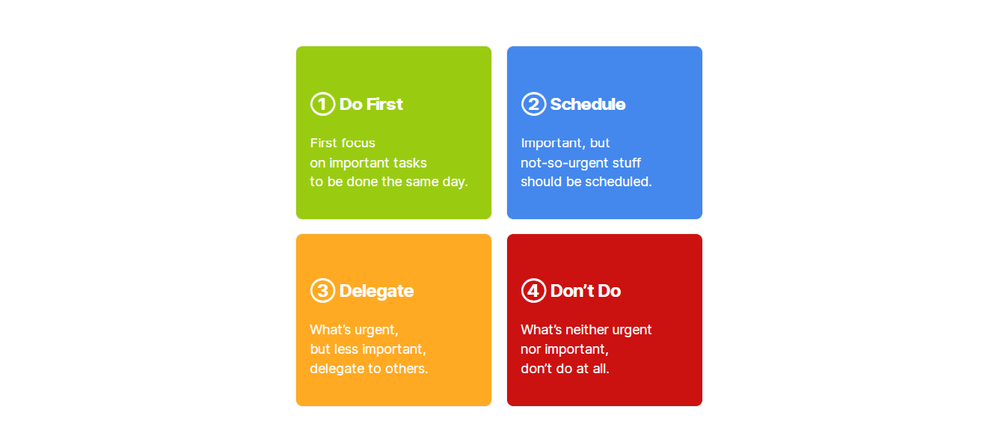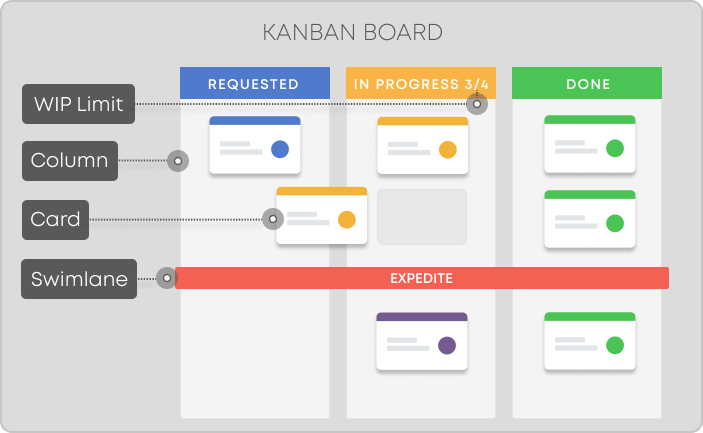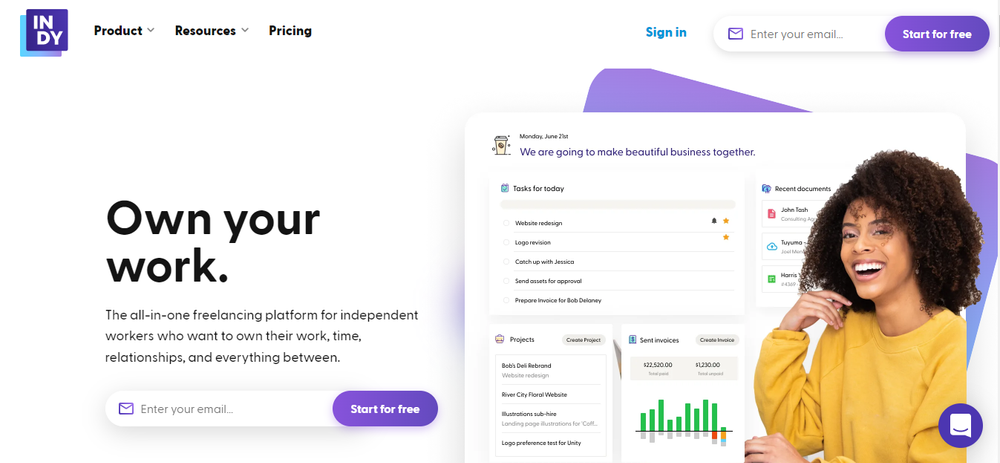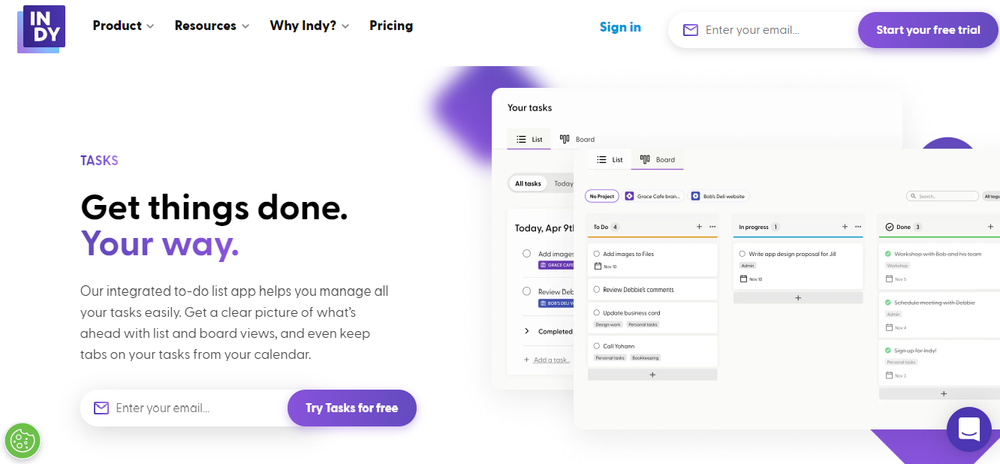When you work as a freelancer, your time is precious. Within any project, there are a lot of tasks to get done within that project, within a certain timeframe. On top of this, many freelancers are working on more than one project at any given time. How much time you spend on a task can directly correlate to how cost-effective your time management is. If you spend too much time on one task as a freelancer, you could actually be throwing away money in the long run.
So, productivity is essential in freelance life. There are four main pillars of productivity, which are:
- Focus
- Time management
- Task management
- Prioritization
These four pillars are essential to effective productivity. When they are all working in flow together, our work gets done, and it gets done to a high standard in a reasonable time frame. If any of the pillars slip, we aren’t functioning at our highest possible levels of productivity, and our projects can go sideways. As a freelancer, it can be very hard to work your way back from situations like these.
In this blog, we want to focus only on the pillar of prioritization within the productivity model. We think that this one aspect of productivity is criminally underrated. Most of us know straight away that if we want to be productive, then we need to focus, and we need to plan out our time. However, not nearly enough of us consider task prioritization as an essential pillar of productivity. We don’t prioritize tasks in the way that we should to optimize our time spent working, and this is a mistake.
Task prioritization, when executed effectively, can have a hugely positive influence on your work and productivity. It can help you stay on top as a freelancer, hit your targets, and manage your goals. If you aren’t actively thinking about prioritizing tasks or using any kind of task management tool, you are missing out and you are at a disadvantage when compared to your freelancer competitors.
With that in mind, let’s look at the best tools you can use to prioritize tasks.
1.Eisenhower matrix

The Eisenhower Matrix is also known as the Important-Urgent matrix, and it was first described by former US President D. Eisenhower. It is a model that intends to help people manage big workloads and long lists of tasks in a more productive way. It is a priority matrix that helps you qualify your tasks as either urgent and important, urgent but not important, important but not urgent, and neither.
Eisenhower had to make many decisions each day, and he found that the only way he could manage to do everything he needed to was to use this priority matrix. If something is important and urgent, then it is done first. If it is important but not urgent, then it should be scheduled in your calendar for some point soon. If it is urgent but not important, then you should delegate it to another member of your team. And, finally, if it is neither urgent nor important, then don’t do it.
The Eisenhower Matrix is a prioritization tool that has a lot of potential worth for freelancers. With so many tasks to do across different projects, having this matrix as a go-to for dividing and prioritizing your tasks is a wonderful resource. It makes sure that you handle what needs to be handled and that you don’t waste time on what doesn’t need to be handled at all.
If you try it, you will see just how much stress the matrix can get rid of. That is a real treat in itself for busy freelancers.
2.Pareto principle
The Pareto principle has a few different names in the world of productivity, including the 80/20 rule and the principle of factor sparsity. Whatever it is called, it is a concept relying on the principle that 80% of consequences/outcomes come from 20% of causes/effort. The principle is used in lots of different areas, including politics and mathematics.
In the world of personal productivity, the Pareto principle can greatly help in the process of time management and creating a prioritized task list. You can use the principle that 20% of your effort will result in 80% of the outcome by prioritizing the tasks in your day that have the biggest impact on your projects. In other words, there is no point in spending 8 hours on little tasks that won’t push you further along, especially if you are already behind on deadlines. It is much more worthwhile to spend 2 hours working on high-impact tasks that will help you move more quickly towards your goals.
The Pareto framework also includes steps for making decisions within your work. These include:
- Identifying problems
- Identifying the underlying cause of the problems
- Scoring each problem on a scale of importance/impact
- Grouping problems into similar categories
- Adding each group’s scores together
- Addressing the highest-scoring groups first
Using these steps is an amazing way to structure your day as a freelancer. In a busy week and/or a busy project, this framework can help you quickly prioritize your time in a way that you will get as much benefit as possible from the time that you have worked.
Writing out the steps and grouping and scoring your complex tasks might add an extra 10-15 minutes to the start of your day, but it can ultimately shave off hours and hours of time throughout the week. That is certainly worth it if you ask me.
3.RICE
RICE stands for reach, impact, confidence, and effort. It is another wonderful task prioritization tool that is helpful for work and work-related jobs or tasks. Each aspect can be further described as follows:
- Reach: The number of people/clients/readers that will be impacted and influenced by a task and its completion.
- Impact: Outcomes such as profit, conversion, client rapport, and so on. This aspect quantifies that of “reach”, so when combined, they prompt you to think how many people will be influenced and by how much.
- Confidence: Your own level of confidence in your estimates. If you only think a little bit that a certain task will have a large reach and a strong impact, it is worth re-considering. Many people calculate the confidence aspect of RICE as a percentage, i.e., I am only 40% confident that this task will have a strong impact.
- Effort: This one is pretty simple. Effort is how much of your time, concentration, and focus will be wrapped up in completing this task.
Calculating your RICE score for a task means tying all of these aspects together to rank your tasks for the day, week, or month. The formula is (Reach x Impact x Confidence) / Effort.
Here is an example.
Task 1: Writing a new email campaign
Reach = 500 people
Impact (Where 3 is massive, 2 is high, 1 is medium, low is 0.5 and minimal is 0.25) = 2
Confidence = 80%
Effort (for us, calculated in hours) = 4
The sum, then, is: 500 x 2 x 80 / 4 = 20,000
This score would demonstrate to us that our task should be of very high priority. It will have a big impact on us and our goals, and it is definitely worth your time. On the other hand, here is an example of using the RICE framework to get rid of a task from our schedule as it is a low priority.
Task 2: Make the 45 revisions requested by a low-paying client on a piece of work we deem to be already of good quality
Reach = 1 person
Impact = Low, 0.5
Confidence = 60%
Effort = 4
The sum: 1 x 0.5 x 60 / 4 = 7.5
As you can see, when comparing a RICE score of 20,000 versus that of 7.5, we know exactly how to prioritize our complex tasks for the day and where to put our time for maximum outcome. The task with a very low score should be delegated to someone else or not completed at all. While this isn’t always easy, it is essential if we want task and time prioritization to really work for us and our own productivity.
Again, using this framework adds another task in itself during your day or week, but it is one that definitely repays itself and proves its value in the time it goes on to save. It is a great way of brutally cutting out tasks that don’t have enough value for you and of making sure that you understand the importance and value of other tasks on your list. Getting these two mixed up is where you will see time wasted and devalued throughout your week.
Nobody wants that in freelance life.
Taking the extra time to sit down and work out the RICE scores for your upcoming tasks can help you get your work completed faster, manage your priorities, and overall have a happier work-life balance. Adding a numerical value to things helps justify your decisions to yourself, and that can provide a lot of peace of mind.
4.The action priority matrix
Source: https://www.mindtools.com/pages/article/newHTE_95.htm
The Action Priority Matrix is quite similar in form and purpose to that of the Eisenhower Matrix. It is a scaled quadrant that helps us figure out how we should prioritize and organize tasks that we have. Sometimes even when we know that we need to prioritize our work, it can be hard to know how to do that and what criteria we should be using to rank them. This is where The Action Priority Matrix can come in to help.
The matrix helps us put tasks into one of our four boxes: “Quick wins,’ “major projects,” “fill-ins,” and “thankless tasks.” These boxes are scaled with the criteria of ‘impact” on the y-axis and “effort” on the x-axis. So, “thankless tasks,” for example, would be low on the impact scale and high on the effort scale, so those tasks are not worth prioritizing. Quick wins, on the other hand, are high on the impact scale but low on the effort scale, so they are worth prioritizing highly and getting out of the way.
A matrix like this can help give our work day a lot of momentum. It can help boost our productivity by achieving quick wins and successfully prioritizing our major projects, and it helps us to leave out any negative impact from thankless tasks and time drains.
If you use the Action Priority Matrix in your work week, you will find yourself flying through work and cutting out lots of the low-hanging fruit while you are doing it.
5.Eat that frog
The ‘Eat That Frog’ motto for productivity was popularized by Brian Tracy in his time management book by the same title. The words themselves, however, hail back a little further to none other than Mark Twain, who famously wrote,
“If the first thing you do each morning is to eat a live frog, you can go through the day with the satisfaction of knowing that that is probably the worst thing that is going to happen to you all day long.”
The Eat That Frog principle, therefore, encourages us to start our day or week with the item on our to-do list that we want to do the least. It urges us to not move on to any other task until we have eaten the frog, i.e., done the boring, laborious task that we have been dreading all weekend.
The thought process behind the principle is that once you have eaten your own frog, you will get a sense of relief and achievement that will allow you to move forward on better and more important tasks. The theory is that this will make your work day feel better, go quicker, and allow for more success.
It is notably in contrast with a lot of the other models on our list, who encourage us to start with the quick wins or the most important tasks of the day. But it is very useful for a lot of people and can be worth giving a good go.
It might make Mondays feel a little worse, but it will make Fridays feel all the better.
6.Kanban boards

Source: https://kanbanize.com/kanban-resources/getting-started/what-is-kanban-board
Kanban boards originate from a visual scheduling system developed as part of the Toyota production system. In 2007, the model was taken further by David Anderson, who wanted the model to become a tool for agile project management.
The basic premise of Kanban Boards is very simple, and yet its results can be very powerful. They are visual task management boards that allow you to sort your work tasks into the three categories of “requested,” “in progress,” and “done.” Tasks are represented as “cards” that move between the three columns and the stages of the workflow. They can be either in physical or digital forms, depending on what is more worthwhile and stimulating for each individual user.
Kanban Boards are great for people who think visually and who like to have a sense of completion and satisfaction throughout their workflow. Sometimes when we work on multiple projects, things can get very jumbled and confusing, and this causes us to stagnate and slow down. Keeping things clear and visual in a board in front of you helps to remind you all that you have to do at any given time and helps you to work through all of these tasks at a steady and consistent pace.
Kanban Boards are perfect for busy freelancers, and the best thing is that they are not time-consuming or another task within themselves. Finding the right Kanban Board tool can really speed up your work and keep you feeling good about yourself and your progress in the meantime. That is an almost dreamy scenario for freelancers to think about.
7.Project management tools
The ultimate best way for freelancers to make use of all these models and principles of productivity is to find the right project management tool that will offer access to them. You don’t want to spend more time creating your boards and tools to help you manage your time more effectively; there would be an irony in that.

Tools such as Indy have task prioritization built in their very being. The project management tool helps you build task prioritization into your everyday work life in a way that is accessible and ready to go. The life and brain of a freelancer can both be very scattered, so using a cohesive, all-in-one PM tool helps streamline everything into an efficient and productive system.
Here is how Indy’s key features can help you maximize your own productivity by organizing tasks:
- Built-in task management boards: With boards akin to the Kanban model, you can use Indy’s Tasks tool to create tasks and organize them within projects. You can add due dates, project links, and tags to each task card, and then you can move these individual tasks through the workflow process. You can get the satisfaction of clicking “completed” when finishing a task, and you can keep tabs on everything that you have on your mind in a much easier way.
- Prioritizing tasks by filters and tags: For each task you create in Indy, you can quantify it by adding filters and tags. You can also pin tasks to the top of your dashboard to give them a visual priority.

Quantifying your tasks into what needs to be done first is a great way to keep yourself in a smooth flow. You can refer back to the models we have talked about in this blog to remind yourself how to rank and score tasks before you tag them. Whether you want to eat the frog or put the high-scoring RICE tasks first is up to you.
- Integrate tasks with your calendar: Indy’s task management software is integrated with the Calendar tool. This means that you can manage your tasks in an easy-to-read daily schedule. You can create due dates and keep an eye on those looming deadlines. Keeping track of the time you have left can help you use the formulas described here and can further help you prioritize your tasks based on the schedule of deadlines and task due dates. There is, in fact, only limited time in the week, and it is important to be realistic about that when planning your workload so you can meet deadlines.
- Time tracking: Time is money, and money is time in the freelancing world. When it comes to knowing how much time you can delegate to certain tasks, it is good to review how much time these tasks usually take you. With Indy, you can start a timer for your work and keep track of how long it is taking to complete certain aspects of a project.
You can then attach this time to projects and use the data to reflect on your systems of practice. This will help you know how to manage your time going forward and help you prioritize tasks within that time. You can also send your realistic timesheets directly to a client to be billed, which is a big bonus, and another time-wasting activity shaven off your schedule.
Your overall takeaway from this blog is that your time is precious as a freelancer, and you need to use it wisely. To do so, the best practice is to tap into the amazing productivity and prioritization tools out there at our disposal. To make your life even easier, you can use a project management tool like Indy that incorporates all of the knowledge and utility of these tools into one place. From there, you can be more productive and efficient than ever before.



